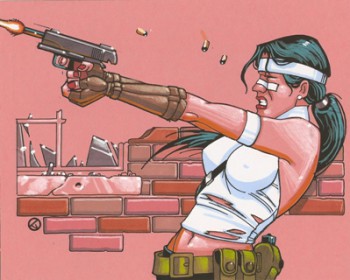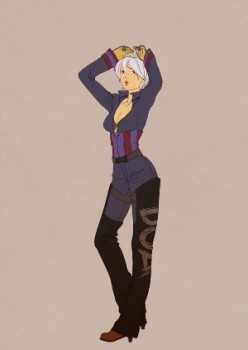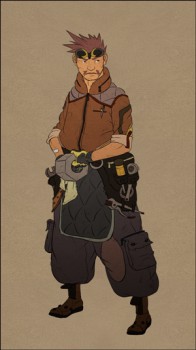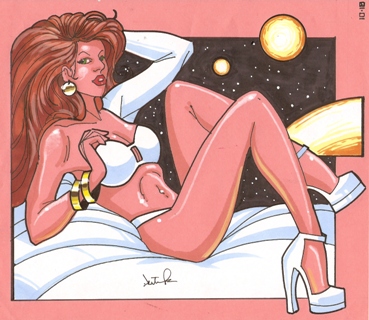Art of the Genre: Outsourcing Art
Last year I was in a pickle concerning a project I’d been working on for a decade. I was looking to complete a demo deck of a card game but to do that I needed art. Art, however, isn’t cheap, and although I had a dozen established friends in the industry who were artists, even ‘friend’ rates for color renderings were running minimally just over one-hundred dollars per card. With one-hundred fifteen individual pieces, that would come to $12,650 just for art.
During a discourse with David Deitrick, we talked over numbers and what some of his art might look like. I invested the going rate of $110 to see what I’d be getting for the game because I thought David’s talents lent very well to the post-apocalyptic theme.
David did up this wonderful piece, and although I loved the style, in the end there was no way I could afford to pay him for the entire project. Knowing that all my other artist contacts were in the same range or much higher, I did what any red-blooded entrepreneur would, I looked to outsource.
The advent of the Internet has made finding artists easy, just take a look at a full world of ready to employ artists on DeviantArt or Elance. It’s simple, just log in, find a message board, post what you want, and let the portfolios flow in.

Did I feel bad? Sure, who wouldn’t… I have friends, real friends, who are struggling for work, wondering where their marketplace went and why companies that used to love them won’t return their calls and yet I’m ‘slumming’ for artists in Thailand. My initial thought was who wouldn’t rather want to throw a friend some available business even if it cost a few extra bucks, like if I go to Target and buy a T-shirt that’s made in the U.S.A. for $20.99 instead of $18.99 that is made in China. However, when the bids came in it very quickly ceased to be ‘a few extra bucks’ but something much more profound. All told, when the bidding war ended, I still gave my money to an American, Tong Bui, a struggling college student in Northern California, but at an unbelievable rate of $13.30 per original color card.
Ok, so using DeviantArt I just saved $96.60 per card for a total of $11,105 saved overall. How freakin’ insane is that? Would a real friend fault me for those savings? [Note: Yes they would, artists are not the forgiving type by nature.] 
Side Note: In a conversation with Joseph Goodman of Goodman Games he told me point blank, ‘Art is cheap, don’t spend your budget on art’. It was funny, because at the time I thought, ‘is this guy crazy? Art MAKES the book.’ What I didn’t realize is that ‘good’ art can be faked to a flash and bang driven high-school consumer. The reality is there are so many artists out there you can spend next to nothing and at least get in the proximity of the desired look you want. Remember, however, that Goodman also built his entire company from the Dungeon Crawl Classics lines that utilized cover images from Erol Otus, Jeff Dee, Jim Holloway, and Jim Roslof so I still take his advice with a grain of salt.
Next question, and I’m sure the one that’s on your mind, what about quality? Well, I’m not here to be Lazarus Chernik and give a critique, so I’ll let you all be the judge. Would I rather have had Todd Lockwood than Tong Bui, sure, I mean it is Todd Lockwood after all, but Todd doesn’t come cheap. In some cases, artists of his caliber are paid upwards of $2000 per card image, so art in a deck of Magic the Gathering might cost Wizards of the Coast $80,000 or more up front.
Sorry, back on topic, I.E. quality. Well, having seen what Tong could do, I decided I wanted to test the field on a more standard image rather than a card and see what would happen. I went back to David Deitrick, veteran gaming artist and sci-fi specialist with more than thirty years of industry experience to quote me a price for a color piece of art concerning a sci-fi short story I wrote. He said he’d do a limited color piece for the friend price of $50. I agreed, and sent him the specifics of the picture.
Now before I go further, let me set that stage for this commission. The scene takes place in the future, a red-headed model doing a fun in the sun photo shoot spies a relic old earth red biplane, takes the pilot’s jacket and goggles, and produces a cover worthy image before all hell breaks loose. I sent David the entire written scene, and after a week, he sent me a digital version of the commission, no original which I assume would have cost extra. 
So, I had a veteran American gaming artist version for this commission, now it was time to once again test dollar for dollar value. I went to DeviantArt again and found a French/Korean named Teddy Chindavong who I thought was in my price-point. He listed a color piece of art, digital copy only, at $50. Contacting him, I sent him the same info as David, and remember Teddy is French-Korean, so English is his third language, but he took what I wrote and gave a timetable of four days.
Here is what I got for my $50 from the overseas markets, this time Western Europe, so I’ve yet to even tap the Southeast Asian market or the Eastern Europe frontier. What I came to understand here is that there is a glutton of artists on the open market, and that you can well exploit their burgeoning talent assuming you enjoy their style and have the ability to pay.
Both of these young artists, Tong and Teddy, are college students, and can draft digitally very quickly on whatever computer their parents bought them before going away to school or that they’ve built up over their high school years on birthday money and with summer jobs. Looking back on my college days, I would have given just about anything for someone to email me out of the blue and offer me $50 for a short story I was probably going to do anyway as I practiced my craft between classes, parties, and dating.
The above, in its essence is the hard part, the fact that these kids can charge next to nothing because they have relatively nothing to worry about. There are no wives in these artist’s lives, no children, no mortgages, car payments, electric bills, etc. They, like an online retailer, have no overhead, and therefore can undercut artists that have paid their dues in the industry of hard knocks and are now required to charge what they do just to stay afloat. 
Technology makes this all possible. The advent of the digital medium and the Internet to promote young artists looking for a taste of the big time changes the way established medium-grade artists die in the industry they once thought they could retire in. For the top ten percent, these young guns won’t have an impact, but that still doesn’t mean the creeping doom of these barbarians at the gates isn’t being heard or felt all over.
Side Note: Jeff Laubenstein was once the hottest artist at FASA, which was also the hottest gaming company in the world next to venerable TSR. One of the co-owners walked up to him one day in the midst of all the success and just kind of matter-of-factly said ‘don’t think of this as a permanent profession’. Jeff, a true company artist, sat stunned at the audacity of the statement, and yet eight years later FASA was defunct, Jeff was searching for freelance gigs, and cheaper new talent was filling the pages of brand new gaming companies that didn’t know or care who this twenty-year vet was.
Even legends like Jeff Easley are feeling the pinch, WotC parting ways with him after a twenty-five year run, and as publishers look to tighten their already shoe-string art budgets, it doesn’t take much for a big name to fall out of favor for an up and coming talent at a quarter the price. Remember, gaming art in its essence is driven by youth, and a youth market is easily diverted to the next big thing.
The greatest sadness here, in my opinion, is that the only ones getting any benefit out of this new world order are the companies. The cheap labor is great for their bottom line, but loyalty doesn’t exist [I just proved that], and there are always more up and coming artists to fill the shoes of those displaced, especially the college freelancers who believe the their early ‘success’ will equate to a future in the business where they can make a living. $50 every week or so is great when you are living off the parents dime, but it won’t keep you fed in the real world.
This is the world of the incredible shrinking middle class, the realm of 99% of wealth held by 1% of the population. This also reminds me of the fall of middle-grade writers, the average lifespan of a published author in the U.S. at a staggering rate of 5 ½ years. To survive at a comfortable rate in the industry of creativity isn’t plausible in the current marketplace, and I find it a sad testament to my experiment and where we are going as a nation.
In the end, when I asked David about this whole affair, he came back with this well-educated response that only David could, “I imagine craftsmen at the dawn of the industrial revolution felt much the same way. They worked and slaved through an apprenticeship – then spent years honing their skills only to have some canny Scot make some sort of mill that reproduced their crafts through a water-wheel or donkey power.”
Outsourcing and the Internet are our next Industrial Revolution, but unionization can’t solve the problems of this type of worker exploitation, and so we’ll have to find another way or fade into artistic oblivion.
Fascinating experiment. Thanks.
Jeff: Glad you enjoyed it. A different world for sure to be sure, I just wish I could say it was a better one 🙁
The law of supply and demand…sucks when there is a glut of people doing what you do as well as you do it, but rocks when you are the one in a million, or billion.
TW: Yeah, and with the world shrinking, I’ve found there are WAY too many people that do everything I do much better than I can do it 🙂
While I can definitely sympathize with your feelings on the cost of art, if we are unwilling to shell out the big bucks for art (including and not limited to offering a competitive price for art from these young up and comers, so they have a reasonable understanding of what they should be selling their work for in the market!) we are contributing to the collapse of the market!
I can see your impressions of technical accuracy over artist style in your choices here, but style is one of the most important factors in art. While Mr. Dietrick’s art has what you might call a more ‘cartoony’ look than your two commissioned artists do, his style has action and character that theirs lack. I’m not saying one’s better than the other– in fact, I’m saying they’re all of equal quality, and beauty is in the eye of the beholder– but I do think that active poses, sense of character and action are incredibly important to art and often forgotten in the business models.
While Chindavong and Bui’s commissions are more technically accurate, they lack motion and expression, which are the stuff that art is supposed to be made of. Dietrick’s art is kind of generic and highly stylized, but I can tell that the woman shooting the gun is much angrier than the slightly playful smile of the model; Chindavong’s model’s expression is completely flat, and Bui’s characters are stagnant. I will say that Chindavong and Bui have the potential to become much better artists if they are, indeed, up and coming; having technical accuracy at an early age only helps with the later development of expressive art, just as a thorough understanding of the English language is a great foundation for writing excellent creative stories.
The heart of this matter is that in performing your experiment, you touched upon the blackest heart of the art industry. Many corporations right now scour Deviantart and similar sites for artists who are unaware of the going rate, intentionally seeking out artists for cheap because undercutting the existing artists for some quick profit– and treating the artists on a given project with as little respect as possible– are considered good business practices. It’s shortsighted and it’s dangerous, because it destroys the market at its source. Like I said before, I understand being too short on cash to shell out 12$K on a project right away. The reason that relatively big companies like Wizards can afford to shell out 80$K for their art, to borrow your numbers, is that they are big enough and old enough to expect that their profits will far exceed the price on the art even if they DO pay rates that are a bit more fair to artists as human beings.
The only thing I find wrong with your approach is assuming that since you’re commissioning ‘young, impressionable artists’ it’s okay to marginalize their costs of living, assuming that they’re students who are living on ma and pa’s dime. Let me just say as someone who’s spent a lot of time in the web community and BEEN a college student recently enough to remember how scary it was living paycheck to paycheck…the vast majority of students going to college seriously are NOT well off and they are NOT living on their parents’ money. Even if they are, what right have you to dismiss their needs? Those that do live at home frequently do so to try to reduce cost of living so that they can accrue less of the colossal debt that comes of being a college student. Sure, it’s possible he got a computer from his parents, but it’s just as likely that he saved up his money earned through part time jobs to buy it himself. Assuming the worst of artists certainly doesn’t help to improve the market, or opinions of artists in general– worse, if it gets back to these artists, it can very likely devalue their opinion of you and people in your market as future business opportunities.
I for one am very pleased to see how much young talent is out there, and hope it will be nurtured by great teachers and good business partners with moral integrity so that the standard of art quality can be raised all around. As one who dabbles in artistic ventures when I’m not writing long comments on websites, I’ve definitely benefited from the forgiveness of the digital medium versus good old fashioned pen and paper! But at the same time, I think all art has its place. There is a degree of wonder and quality that cannot be recaptured in art that is done entirely digitally. You have too much power to fudge details and make mediocre art look much more impressive than it truly is; like musical performance, the live stuff is a different medium from the technologically created stuff.
Very interesting article, all in all. Just wanted to iterate again that the style should definitely be a consideration in any art venture; say you were looking at Picasso and Dali. You might consider Picasso’s art simplistic compared to Dali’s, but the truth is that Picasso’s cubism is a wholly different style and medium of expression than Dali’s surrealism. Important, very important, that we remember to acknowledge the genres of art, just as we acknowledge the genres of fiction!
Lydia: Thanks for taking time to comment, and I loved your words. As I tried to say in the article, I’m not making a critique of art in the above, just trying to show dollar for dollar and the reader could decide what they thought, as it seems you did, which is awesome.
There is a dark heart in every industry today in the United States, my experiment just trying to show that fantasy art is no different.
I do know this, as much as elder artists struggle, and they struggle a lot, not one of them could be paid enough money to be twenty again and trying to break into this industry. This tells me that things are only getting worse for all those wonderful talents now starting out, so I wish them well, and you if you have just graduated and are looking for a long-term career in any field.